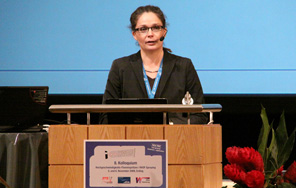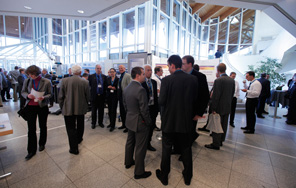|
|
|
|
||
|
||
|
|
||
|
|
||||||
|
||||||
 |
 |
| Prof. Kirsten Bobzin, Head of IOT at the RWTH University Aachen and President of GTS, speaking to more than 420 participants from 23 countries. | Ample space for conversation and networking
– participants at the exhibition directly adjacent to the auditorium. |
A second focal point of the colloquium was the
relatively new process, cold spraying, first invented by Russian
scientists and further developed and made ready for market by the Helmut
Schmidt University Hamburg, Linde AG and CGT Cold Gas Technology GmbH
Ampfing. By utilizing a wide range of metals and alloys, the possibility
of manufacturing extremely dense and oxide-free coatings, whose
properties come close to matching the values of solid material produced
with metal fusion bonding, has opened up a window of opportunity for new
thermal spray applications. In addition to presenting detailed process
analyses and process equipment which is now commercially available, a
large number of examples illustrated the industrial manufacture and
application of coatings. These further underscored the potential of this
new coating method.
Alternative methods for new areas of application
Yet another series of presentations dealt with new developments in
plasma spraying and arc spraying. Besides the air plasma (APS) torches
with one pair of electrodes, already widely used in industry today, new
torches with three cathodes now provide higher deposition efficiency and
enhanced process stability. However, it would seem that the broad
spectrum of possibilities which plasma spraying already has to offer has
not yet been exhausted. Multi-cathode and multi-anode technology as well
as the fluid dynamic adaption of nozzle configurations have now been
joined by further plasma spray developments, such as the trend to higher
particle velocities. Arc spraying also promises further potential for
new developments. By using shielding gases or mixtures of shielding
gases and reactive gases to atomize the spray particles, it was possible
to demonstrate how the burn-off of alloying elements and the oxide
content in the coating could be reduced.
An important resource when developing new spray processes and systems
are the diagnostic methods which measure and record the particle
temperature and velocity. A paper by the University of the Federal Armed
Forces Munich looked at the variety of means available to achieve this.
Here, special emphasis was given to those methods which can also be used
to monitor spray processes.
Of increasing importance: quality and certification
The second day started off with a series of presentations which
confirmed how invaluable and also indispensable it is to provide and
have thorough and comprehensive education and training, a systematic set
of rules and regulations in the form of standards and technical
bulletins as well as an effective quality assurance and certification
system for thermal spraying. The major role a well-organized association
can play here was well illustrated by the unique and very clear
certification rules which GTS (Association of Thermal Sprayers) has
compiled. Thanks to GTS activities, thermal spraying is decidedly better
organized than many other technologies.
Practical findings
Reports from industry provided numerous examples of applications from
the so-called “borderland” of thermal spraying. Speakers explained which
criteria should be applied when selecting a process or a spray material
in order to achieve optimum quality combined with high
cost-effectiveness. Other presentations dealt with the advent of
nanotechnology in relation to HVOF-sprayed tungsten-carbide coatings.
Yet another impressive report from CSIRO in Australia focussed on the
close cooperation between the CSIRO research centre and its various
industrial partners. With the backing of state funding programs, these
joint activities have helped to implement the cold spray applications
already available and provide the necessary impetus for new
investigations.
Trendsetting developments
The diversity of HVOF developments and applications presented at the
colloquium aroused the audience’s expectations and interest in no
uncertain terms. Once again, it became very clear that the range of
applications for this technology has by no means been exhausted and that
the active cooperation between the research sector and material and
equipment manufacturers will constantly help to make inroads into new
fields of application and enhance those which already exist. Very much
worth noting as a “trendsetting” development are some of the
observations made at the end of the two-day conference: many experts who
had previously viewed cold spraying with a somewhat critical eye came to
the conclusion that this coating technology, with its many existing
applications, had in fact already established itself on the market and
can now look forward to an extremely prosperous future. The organizers
of the HVOF Colloquium will continue to closely monitor and accompany
the developments in the field of high velocity oxy-fuel flame spraying –
and who knows: maybe, in the near future, we will see each other again
in Erding and can verify this progress together.
| 8th HVOF Colloquium 2009 as seen by one
of the participants “Important – especially when the economy is fraught with tension” Bernd Abler In November 2009, the HVOF Colloquium took
place in Erding for the 8th time. For us, the company ABLER GmbH
& Co. KG, a service provider in the field of thermal spray
coatings, this event has come to play an extremely important
role. It is now indispensable in the series of colloquia and
technical conferences. |
|
|
|
|
|
|
|
|
|||
|
|
|||
| Last updated: 22.12.16 | Home | Copyright (C) 2010 GTS e.V. | |